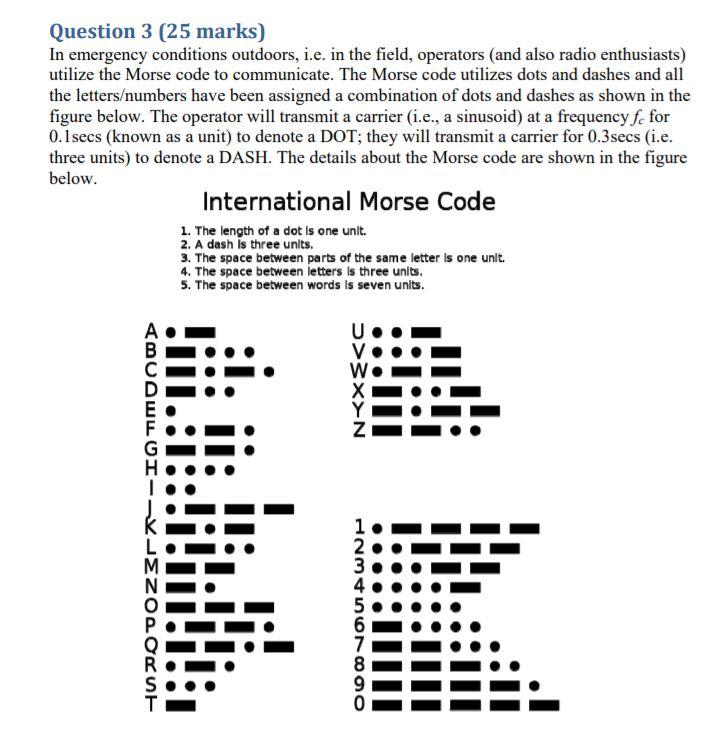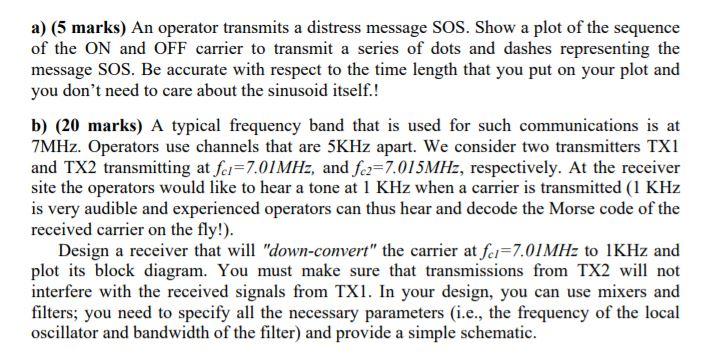URGENT!!! Pls solve it


Question 3 (25 marks) In emergency conditions outdoors, i.e. in the field, operators and also radio enthusiasts) utilize the Morse code to communicate. The Morse code utilizes dots and dashes and all the lettersumbers have been assigned a combination of dots and dashes as shown in the figure below. The operator will transmit a carrier (i.e., a sinusoid) at a frequency fe for 0.1 secs (known as a unit) to denote a DOT; they will transmit a carrier for 0.3secs (i.e. three units) to denote a DASH. The details about the Morse code are shown in the figure below. International Morse Code 1. The length of a dot is one unit. 2. A dash is three units. 3. The space between parts of the same letter is one unit. 4. The space between letters is three unlts. 5. The space between words is seven units. V W Y #moguJu)I-GV-SZoo NE 1 2 3 4 5 6 7 8 9 a) (5 marks) An operator transmits a distress message SOS. Show a plot of the sequence of the ON and OFF carrier to transmit a series of dots and dashes representing the message SOS. Be accurate with respect to the time length that you put on your plot and you don't need to care about the sinusoid itself.! b) (20 marks) A typical frequency band that is used for such communications is at 7MHz. Operators use channels that are 5KHz apart. We consider two transmitters TX1 and TX2 transmitting at fei=7.01 MHz, and fe2=7.015MHz, respectively. At the receiver site the operators would like to hear a tone at 1 KHz when a carrier is transmitted (1 KHz is very audible and experienced operators can thus hear and decode the Morse code of the received carrier on the fly!). Design a receiver that will "down-convert" the carrier at fei=7.01 MHz to 1KHz and plot its block diagram. You must make sure that transmissions from TX2 will not interfere with the received signals from TX1. In your design, you can use mixers and filters; you need to specify all the necessary parameters (i.e., the frequency of the local oscillator and bandwidth of the filter) and provide a simple schematic. Question 3 (25 marks) In emergency conditions outdoors, i.e. in the field, operators and also radio enthusiasts) utilize the Morse code to communicate. The Morse code utilizes dots and dashes and all the lettersumbers have been assigned a combination of dots and dashes as shown in the figure below. The operator will transmit a carrier (i.e., a sinusoid) at a frequency fe for 0.1 secs (known as a unit) to denote a DOT; they will transmit a carrier for 0.3secs (i.e. three units) to denote a DASH. The details about the Morse code are shown in the figure below. International Morse Code 1. The length of a dot is one unit. 2. A dash is three units. 3. The space between parts of the same letter is one unit. 4. The space between letters is three unlts. 5. The space between words is seven units. V W Y #moguJu)I-GV-SZoo NE 1 2 3 4 5 6 7 8 9 a) (5 marks) An operator transmits a distress message SOS. Show a plot of the sequence of the ON and OFF carrier to transmit a series of dots and dashes representing the message SOS. Be accurate with respect to the time length that you put on your plot and you don't need to care about the sinusoid itself.! b) (20 marks) A typical frequency band that is used for such communications is at 7MHz. Operators use channels that are 5KHz apart. We consider two transmitters TX1 and TX2 transmitting at fei=7.01 MHz, and fe2=7.015MHz, respectively. At the receiver site the operators would like to hear a tone at 1 KHz when a carrier is transmitted (1 KHz is very audible and experienced operators can thus hear and decode the Morse code of the received carrier on the fly!). Design a receiver that will "down-convert" the carrier at fei=7.01 MHz to 1KHz and plot its block diagram. You must make sure that transmissions from TX2 will not interfere with the received signals from TX1. In your design, you can use mixers and filters; you need to specify all the necessary parameters (i.e., the frequency of the local oscillator and bandwidth of the filter) and provide a simple schematic








